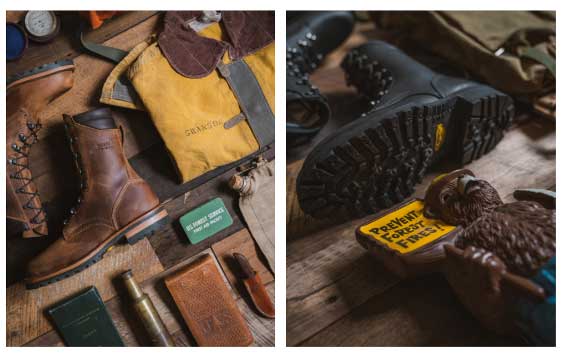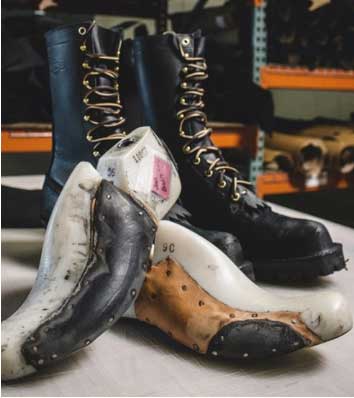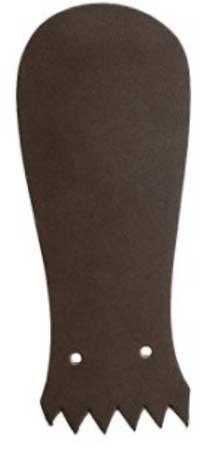How to Select a Wildland Firefighter Boot
 One of the most significant investments you make in your job is a good pair of boots. To discover what type you require, start by prioritizing your needs to narrow your choice. The top factors to consider in boot selection are:
One of the most significant investments you make in your job is a good pair of boots. To discover what type you require, start by prioritizing your needs to narrow your choice. The top factors to consider in boot selection are:
- Fit & Comfort
- Price and ROI
- Styles & Necessary Features
- Quality and Service
Fit & Comfort
As a firefighter once put it – “I’d rather be wearing a pair of flip-flops than $600 boots that are killing my feet with a 5-mile hike back to camp.” While fit usually tops the priority list for selection, don’t overthink it. Keep these tips in mind:
- Your arch should be centered in the boot. Some boots, like White’s Smokejumper, have a pronounced high arch because of their leather shank, which might initially be uncomfortable but will eventually wear in. However, if your arch feels like you are walking barefoot on ladder rungs, prepare for a long, brutal break-in.
- Your toes should wiggle freely. The tip of your toe should be a thumb’s width from the boot tip.
- When you squeeze the outsides (near the ball of your foot and underneath the small toe), it should be snug but not pinch.
- When laced, your heel should not lift when you walk around.
 Speaking of walking around, do just that – walk around for a bit. If you can imagine walking around in your boots while making dinner without thinking about the boot or experiencing any pinch points, then it probably fits fine.
Speaking of walking around, do just that – walk around for a bit. If you can imagine walking around in your boots while making dinner without thinking about the boot or experiencing any pinch points, then it probably fits fine.
Don’t worry about a custom fit. Unless you’ve had serious foot surgery or your chromosomes are half Martian, your feet will likely fit into a stock boot. However, if you want some custom features, like rough out, split leather colors, or extra leather toe covers, you can feel confident that your custom boot will fit much like the stock boot.
Manufacturers use a model or mold called a “last” to construct boots, whether custom or not. Did you know one pair of lasts can cost a manufacturer over $15,000? Whenever a custom boot is ordered, the bootmaker must design around a last that works for most folks.
Tip – Try on lots of different boots with the features you need. It’s best to try footwear on at the end of the day when your feet are more swollen than in the morning.
Price & ROI
Your return on investment can only be based on your financial comfort level. Some folks purchase one cheap pair of boots a month and wear the heck out of them. Others go for the long haul and at least get some better comfort from them. Although there is a good correlation between cost and value, consider a few factors:
Most handmade boots (White’s Smokejumper, Nicks Hotshot, Wesco Firestormer®) can be rebuilt (upperparts and/or lower parts, usually the sole). This knocks off the cost of buying new ones, and you maintain your exact fit. Rebuilt boots look new because the cobblers typically do a great job. Just be aware of the turnaround time.
The quality of the leather is usually the main cost factor. You may not see or feel the difference in leather from one boot to the next, but the value will come with lasting wear and comfort over time.
You don’t buy a $30,000 car for a week’s use; same with boots. Generally, your boots should last a year with daily wear and reasonable maintenance. If you get two years out of a high-end boot, it might cost you less than 50 cents a day. Not bad, considering you are playing with fire.
Consider a good basic bargain boot for the student or rookie budget and experience how they perform. Discipline yourself to maintain them and learn over time from your coworkers about what they feel is essential. The Hathorne or the Danner Wildland Tactical Firefighter are the best bets in this category.
Style & Necessary Features
Matching your specific activities with the features of the boot help make a better selection. Here are a few:
NFPA – Look for an indication that the National Fire Protection Association approves the boots. This certification is a must-have, and most stations require it. It’s the standard in the industry.
Leather – The quality of the leather is mainly based on the thickness and the cut of the leather used. Leather is naturally heat and flame-resistant. It also breathes, stretches a bit, and molds to your foot. The higher the quality of the leather, the better the benefits. When maintaining the leather, use only petroleum-free boot oil or lube to ensure the leather’s integrity. Most other products (saddle soap, mink oil, Vaseline, silicone, conditioners, and anything that claims to be waterproof) break down the leather and provide a false sense of initial suppleness and a clean look.
The Shank – Inside the boot, between the insole and the outsole, lies a thin rod-like material that provides stability and structure for the boot. Shanks differ in material and weight to provide the correct type of wear for the boot. Boots with a metal or composite shank are rigid but offer a quick break-in. Nylon or TPU (plastic-type) provide more elastic and flexible features. The White’s Smokejumper boot has an extremely hard leather shank which allows the wearer to eventually have the boot mold to your foot while providing custom arch support.
Lace and stitching – Look for Kevlar stitching as a tough flame preventative. You don’t want to lose your stitching in the middle of a firestorm. Consider replacing the laces with Kevlar (KG Laces), leather (flame resistant, but not as tough and long-lasting), or Rhino Laces (lifetime guarantee).
Kiltie – A kiltie is a frayed leather piece where the lace stitching starts. The kiltie helps prevent twigs and other foliage from  creeping up your boot laces.
creeping up your boot laces.
Sole & Heel – The type of sole should match the style of terrain where you primarily work. Desert? Rain and ice? Steep terrain? Generally, deeper lugs on the outsole increase stability and durability. It can also reduce fatigue. The depth of the heel assists with steep descents by reducing slippage. White’s claim their Smokejumper’s heel and back heel support cup provide more stability helping reduce fatigue and back pain.
Made in the USA – The United States excels at handmade boot production. It’s a craft developed over time, and therefore the demand exceeds the supply of craftspeople. Although this may not be a material selection, usually, products made in the USA will ensure better quality in material and artistry.
Quality & Service
There’s plenty of online and brick & mortar stores to select from these days. Retailers like BareBones WorkWear® act as ambassadors and provide an assortment to help you make the best selection. Consider the personal factors a store offers, like keeping your purchase history, return or exchange services, custom fitting measurement service, and loyalty programs.
Take the time to consider your needs for performance, comfort, and durability. Once you find a boot you love, you’ll probably get hooked, and when it’s time to get a new pair, you’ll know just what to get.
You can shop around for the boots that fit your goals at CalFireGear.com or at a BareBones WorkWear(R) store near you. Let a BareBones representative guide your purchase journey – connect online or call the BareBones WorkWear(R) Auburn store 530-823-9327 for personalized service on boots and any Cal Fire(R) product.
